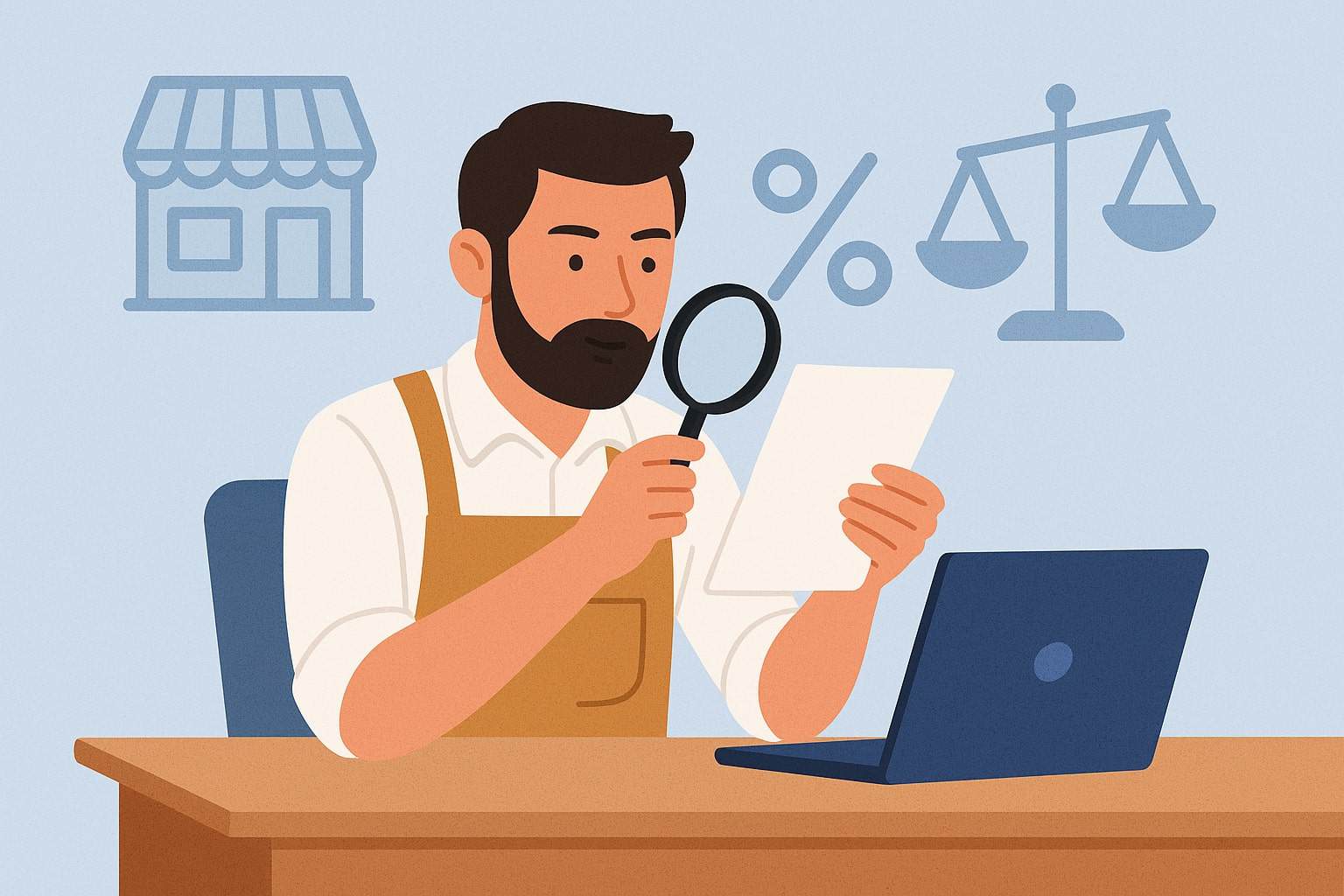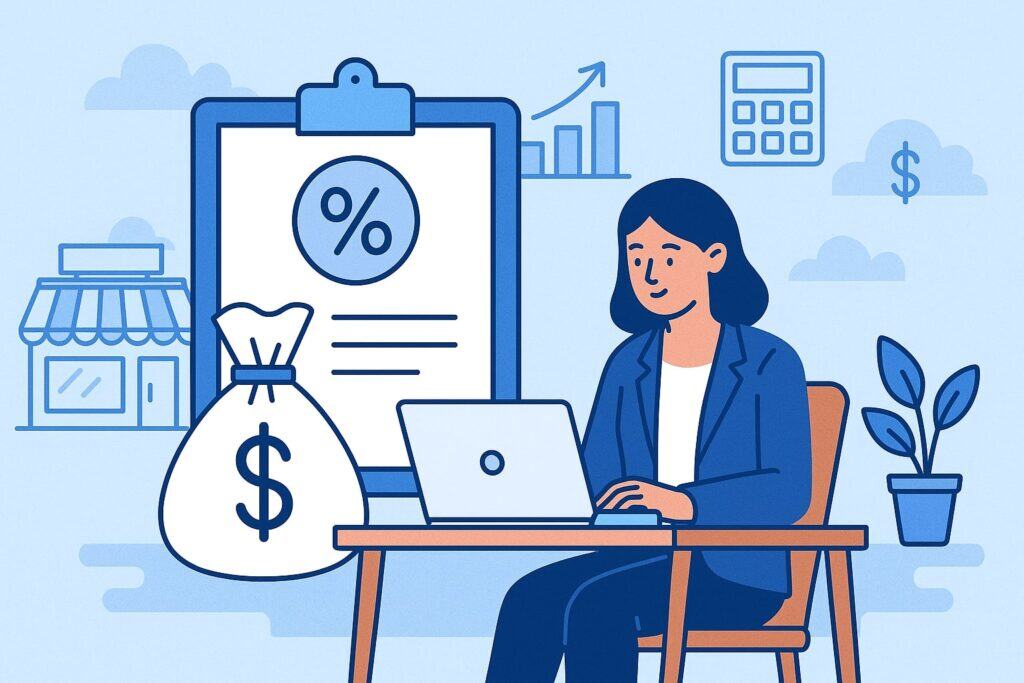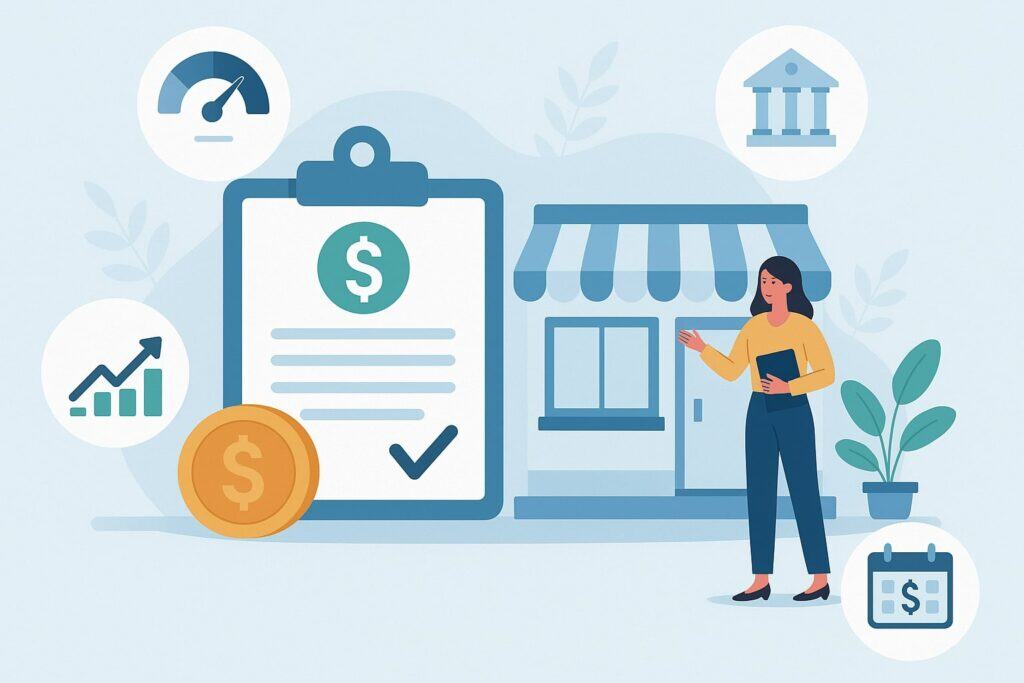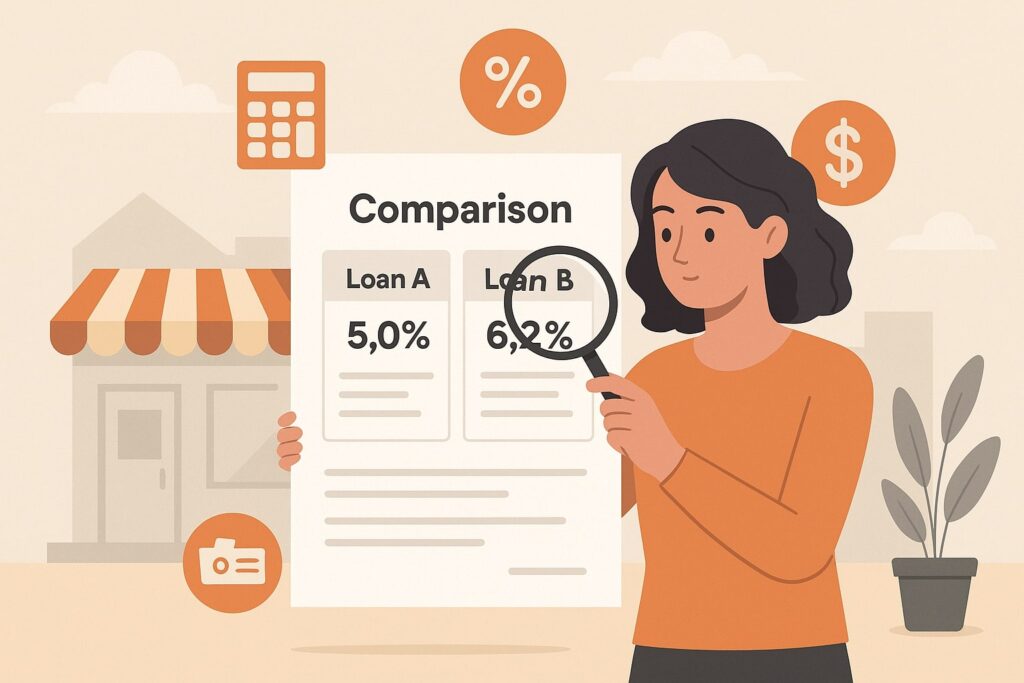
How to Compare Small Business Loan Interest Rates
Small business owners often find themselves needing external funding to expand, manage cash flow, or purchase essential equipment. One of the most common ways to secure financing is through a small business loan.
However, not all loans are created equal, and one of the most critical factors that determine the overall cost of borrowing is the interest rate.
Knowing how to compare small business loan interest rates is not just a matter of looking at the lowest percentage—it involves analyzing multiple factors, understanding loan structures, and considering the long-term implications of repayment.
In this comprehensive guide, we’ll cover everything you need to know about comparing small business loan interest rates, why they matter, what factors influence them, and how you can make informed decisions that protect your business’s financial health.
By the end of this article, you will have a clear roadmap for evaluating interest rates and choosing the best financing option for your small business.
Understanding Small Business Loan Interest Rates

Interest rates represent the cost of borrowing money. When you take out a loan, the lender charges a percentage of the principal amount as compensation for the risk they assume and the opportunity cost of lending money.
For small business owners, even a small difference in interest rates can significantly impact the overall repayment amount, making it essential to understand how these rates are calculated and applied.
There are two main types of interest rates: fixed and variable. Fixed interest rates remain the same throughout the life of the loan, which makes repayment predictable.
Variable interest rates, on the other hand, fluctuate depending on market conditions or an underlying index such as the Prime Rate or LIBOR (London Interbank Offered Rate). While variable rates can start lower than fixed rates, they carry more risk if market conditions change unfavorably.
Additionally, the way lenders present interest costs can vary. Some use the annual percentage rate (APR), which includes both the interest rate and any fees associated with the loan.
Others may only quote the base interest rate, which can make the loan appear cheaper than it actually is. This is why borrowers must carefully distinguish between “interest rate” and “APR” when comparing loan offers.
Understanding interest rates also requires knowledge of how lenders assess your business’s creditworthiness. Factors such as personal credit score, business credit score, annual revenue, industry risk, collateral, and time in business all play a role in determining the rate you are offered.
A higher credit score usually results in lower interest rates, while newer businesses or those in high-risk industries often face higher rates due to increased lending risks.
In essence, comparing small business loan interest rates goes far beyond identifying the lowest advertised percentage. It requires a deeper understanding of loan structures, risk assessments, and repayment obligations. With this foundation, business owners can make informed comparisons and avoid costly mistakes.
Factors That Influence Small Business Loan Interest Rates

When evaluating different loan offers, it’s important to understand the factors that influence how lenders determine your interest rate. These factors explain why two businesses applying for the same type of loan may receive very different offers.
- Credit Score (Personal and Business): Your credit score is one of the strongest indicators of your reliability as a borrower. A high personal FICO score and a solid business credit profile can significantly lower your loan interest rates. On the other hand, poor credit history leads to higher rates or outright denial.
- Business Age and Financial Health: Established businesses with steady revenue streams are considered less risky compared to startups. Lenders typically want to see at least two years of operating history and consistent profitability before offering lower rates.
- Loan Amount and Term Length: Larger loans and longer repayment terms usually come with higher rates since the lender is taking on more risk over a longer time frame. Short-term loans may have higher monthly payments but can result in lower overall interest costs.
- Collateral: Secured loans backed by assets (real estate, equipment, or inventory) often have lower interest rates because the lender has a form of protection if you default. Unsecured loans, by contrast, generally come with higher rates.
- Industry Risk: Some industries are considered riskier than others. For example, restaurants or seasonal businesses may face higher interest rates because of their higher failure rates compared to professional services or healthcare providers.
- Economic Conditions: Broader market factors, such as inflation, Federal Reserve policies, and global economic conditions, can also affect loan rates. During times of high inflation, interest rates generally rise.
By considering these factors, small business owners can take proactive steps to improve their financial standing before applying for a loan.
This might include improving credit scores, reducing debt, or strengthening business financials. The more favorable your profile, the better your chances of securing competitive loan terms.
How to Compare Small Business Loan Interest Rates Effectively

When comparing loan options, it’s not enough to simply glance at the advertised interest rate. A thorough comparison involves evaluating all associated costs and conditions. Here’s how you can approach the process:
Step 1: Look Beyond the Base Interest Rate
Lenders often market loans with an attractive “starting rate,” but that number may not represent the full cost of borrowing. You need to ask for the APR, which includes interest plus fees such as origination charges, processing fees, and servicing costs. Comparing APRs provides a more accurate picture of what you’ll actually pay.
Step 2: Understand the Loan Terms
Two loans with identical interest rates can still have very different repayment obligations depending on term length. For example, a five-year loan at 7% interest may cost much more in total interest than a three-year loan at the same rate.
Step 3: Consider Variable vs. Fixed Rates
Variable rates may be attractive initially but can rise significantly over time. If your business operates on tight margins, a fixed rate may provide greater stability and peace of mind.
Step 4: Analyze Repayment Flexibility
Some lenders offer early repayment without penalties, while others charge fees for paying off loans early. Flexibility in repayment can save you money if your cash flow improves and you want to reduce debt sooner.
Step 5: Factor in Additional Costs
Beyond interest and fees, check for hidden costs such as mandatory insurance, account maintenance fees, or late payment penalties. These can quickly add up and make a seemingly low-interest loan much more expensive.
By following these steps, you can ensure your comparison is accurate and complete. Always use online loan calculators to estimate monthly payments and total repayment costs, and never hesitate to ask lenders for full disclosure of all charges.
Common Mistakes to Avoid When Comparing Loan Interest Rates
While evaluating loan offers, small business owners often fall into common traps that can lead to costly decisions. Being aware of these mistakes can help you avoid them:
- Focusing Only on Monthly Payments: A lower monthly payment might look attractive, but if it’s spread out over a longer term, you could end up paying significantly more in interest overall.
- Ignoring APR: Comparing only base rates without considering fees can mislead you into choosing a more expensive loan.
- Overlooking Loan Flexibility: Choosing a loan with prepayment penalties or rigid terms can limit your ability to manage debt strategically.
- Failing to Compare Multiple Lenders: Many borrowers accept the first loan they qualify for without shopping around. This can cost thousands over the life of the loan.
- Not Reading the Fine Print: Loan agreements may contain hidden clauses such as balloon payments or mandatory arbitration that impact long-term costs and flexibility.
Avoiding these mistakes requires patience, careful reading of contracts, and a willingness to negotiate terms with lenders. Remember, lenders compete for your business, so don’t be afraid to leverage offers against one another to secure better rates.
FAQs
Q1. Why is APR more important than just the interest rate when comparing loans?
Answer: APR, or annual percentage rate, provides the true cost of borrowing by including both the interest rate and any additional fees such as origination charges or closing costs.
While a loan may advertise a low interest rate, it could have high upfront fees that raise the overall cost significantly. By comparing APRs instead of just base interest rates, you ensure you’re comparing apples to apples across different loan products.
For small business owners, this distinction is crucial because cash flow management often depends on accurately predicting repayment obligations. A loan that looks cheap initially might end up being much more expensive once hidden costs are accounted for.
By focusing on APR, you get a more transparent view of the total borrowing expense, which allows for smarter financial planning and decision-making.
Q2. Should I choose a fixed-rate or variable-rate loan?
Answer: The choice between fixed and variable rates depends largely on your business’s financial situation and risk tolerance.
Fixed-rate loans offer stability, making it easier to plan monthly budgets since your payments remain consistent throughout the loan term. This is especially beneficial for businesses with tight cash flows or those that want predictable expenses.
Variable-rate loans, on the other hand, typically start with lower interest rates, which can be advantageous in the short term. However, they carry the risk of rising rates if market conditions change.
Businesses with flexible cash flows or those confident in repaying loans quickly may benefit from variable rates, but they must be prepared for possible fluctuations.
Q3. How can I improve my chances of getting a lower interest rate?
Answer: Improving your chances involves strengthening both your personal and business financial profiles. Start by boosting your personal credit score through timely payments, reducing outstanding debt, and correcting errors on your credit report.
For your business, maintain accurate financial records, demonstrate steady revenue growth, and build a strong business credit history by paying vendors and suppliers on time.
Additionally, offering collateral can reduce lender risk, which often leads to better rates. Building relationships with banks or credit unions where you already maintain accounts can also help, as lenders are more likely to offer favorable terms to existing customers with proven track records.
Q4. Is it worth refinancing my current loan if interest rates drop?
Answer: Yes, refinancing can be a smart strategy if market interest rates fall or if your business’s financial situation improves significantly since you first took out the loan. By refinancing, you may secure a lower rate, reduce monthly payments, or shorten the loan term.
However, it’s important to consider refinancing costs such as closing fees, application fees, or prepayment penalties on your current loan.
Run the numbers carefully using loan calculators or with the help of a financial advisor. If the total savings outweigh the refinancing costs, it’s usually worth pursuing. Refinancing can free up cash flow, allowing you to reinvest in growth opportunities for your business.
Q5. Are online lenders trustworthy compared to traditional banks?
Answer: Online lenders have become increasingly popular, offering faster approvals and more flexible loan products. Many are legitimate and regulated, but they may charge higher rates compared to traditional banks.
The key is to research thoroughly—read reviews, check for Better Business Bureau accreditation, and confirm that the lender is transparent about fees and repayment terms.
Traditional banks may offer lower rates, especially for established businesses, but the approval process is often slower and more stringent. Ultimately, both online and traditional lenders can be trustworthy if you conduct due diligence.
Comparing rates, fees, and terms across both options ensures you find the best fit for your business’s needs.
Conclusion
Comparing small business loan interest rates is not a one-step process but a comprehensive evaluation of multiple factors. From understanding the difference between interest rates and APR, to evaluating loan terms, repayment flexibility, and hidden fees, the process requires careful attention to detail.
By avoiding common mistakes, strengthening your creditworthiness, and shopping around among multiple lenders, you can secure the most cost-effective financing option for your business.
A well-chosen loan can fuel growth, provide stability, and create new opportunities for your small business. On the other hand, rushing into a loan with unfavorable terms can strain your finances and hinder long-term success.
With the strategies outlined in this guide, you are now equipped to make informed, confident decisions that align with your business goals.